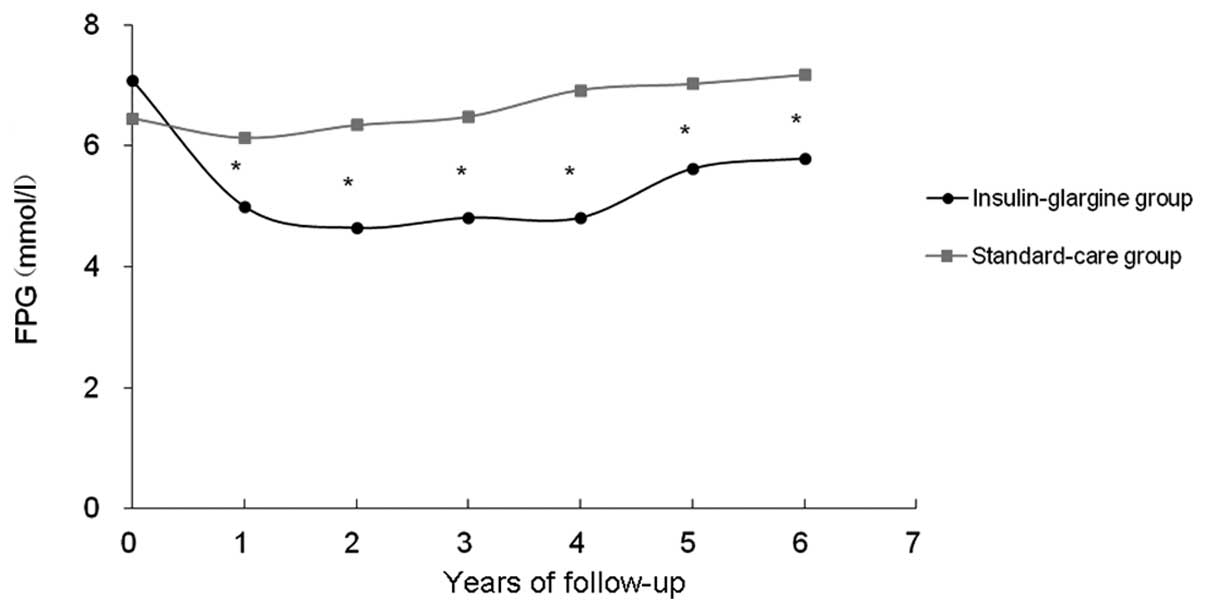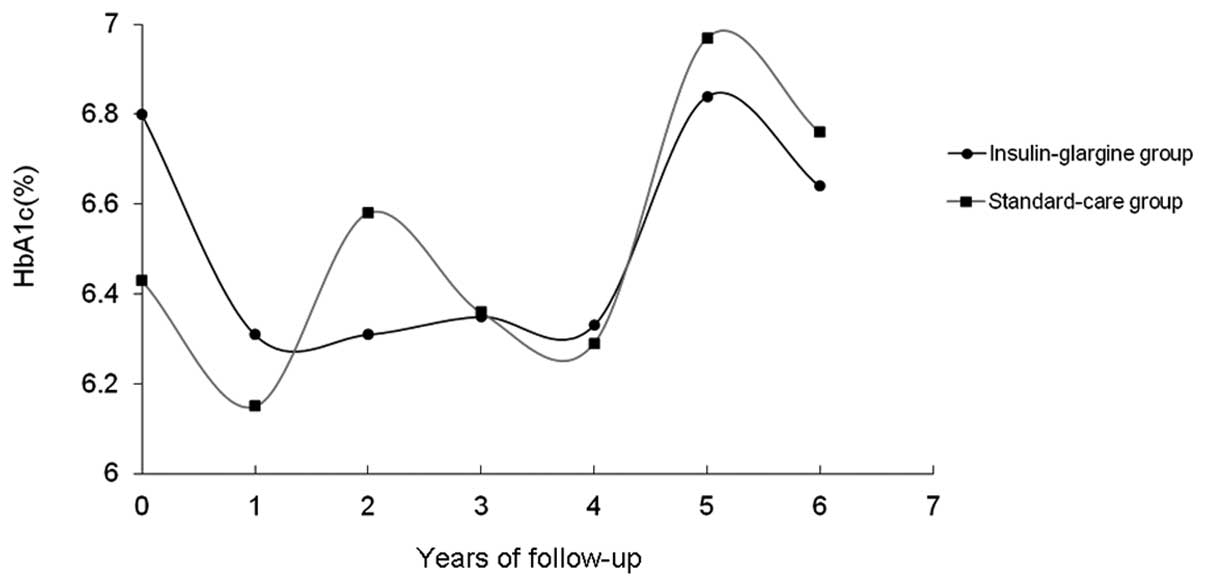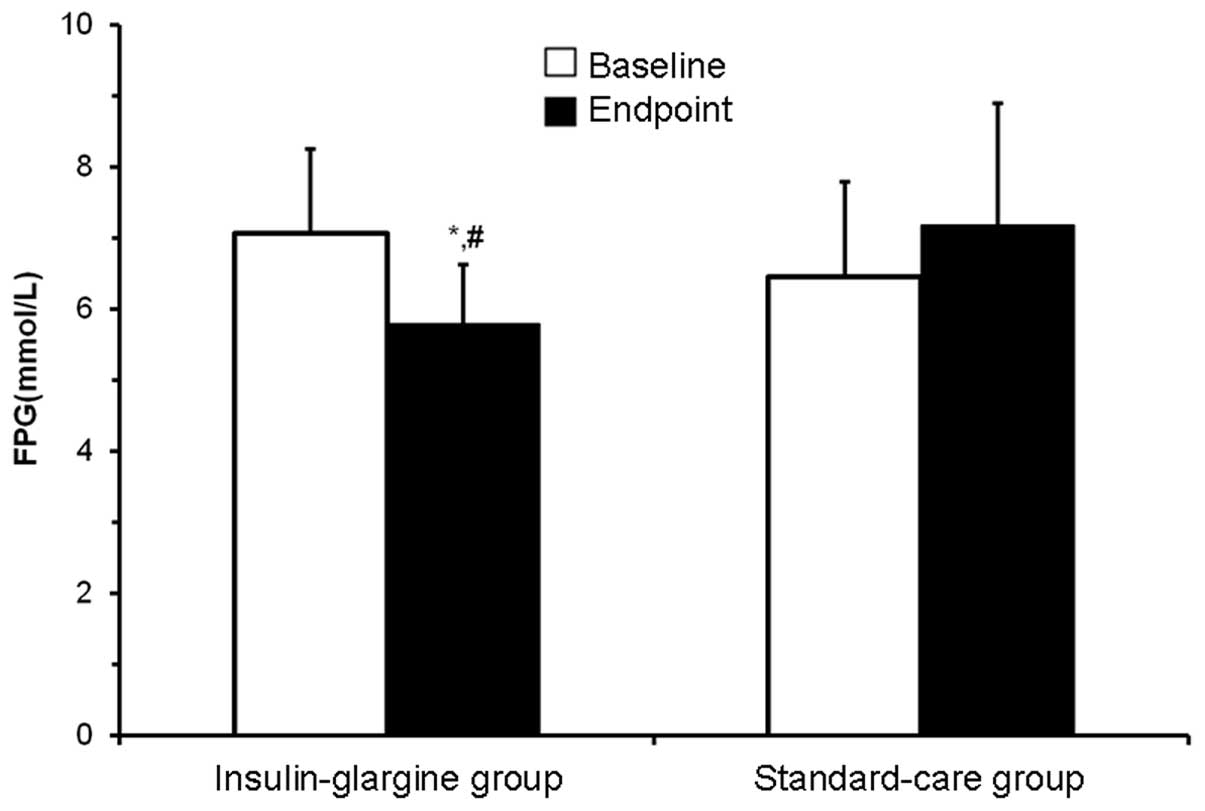|
1
|
Yang W, Lu J, Weng J, et al; China
National Diabetes and Metabolic Disorders Study Group. Prevalence
of diabetes among men and women in China. N Engl J Med.
362:1090–1101. 2010. View Article : Google Scholar : PubMed/NCBI
|
|
2
|
Brunner EJ, Shipley MJ, Witte DR, Fuller
JH and Marmot MG: Relation between blood glucose and coronary
mortality over 33 years in the Whitehall Study. Diabetes Care.
29:26–31. 2006.PubMed/NCBI
|
|
3
|
Hu FB, Stampfer MJ, Solomon CG, et al: The
impact of diabetes mellitus on mortality from all causes and
coronary heart disease in women: 20 years of follow-up. Arch Intern
Med. 161:1717–1723. 2001.PubMed/NCBI
|
|
4
|
Weng J, Li Y, Xu W, et al: Effect of
intensive insulin therapy on beta-cell function and glycaemic
control in patients with newly diagnosed type 2 diabetes: a
multicentre randomised parallel-group trial. Lancet. 371:1753–1760.
2008. View Article : Google Scholar : PubMed/NCBI
|
|
5
|
LeRoith D, Fonseca V and Vinik A:
Metabolic memory in diabetes - focus on insulin. Diabetes Metab Res
Rev. 21:85–90. 2005. View
Article : Google Scholar
|
|
6
|
Nathan DM, Buse JB, Davidson MB, et al;
American Diabetes Association; European Association for Study of
Diabetes. Medical management of hyperglycemia in type 2 diabetes: a
consensus algorithm for the initiation and adjustment of therapy: a
consensus statement of the American Diabetes Association and the
European Association for the Study of Diabetes. Diabetes Care.
32:193–203. 2009. View Article : Google Scholar
|
|
7
|
Hu Y, Li L, Xu Y, et al: Short-term
intensive therapy in newly diagnosed type 2 diabetes partially
restores both insulin sensitivity and beta-cell function in
subjects with long-term remission. Diabetes Care. 34:1848–1853.
2011. View Article : Google Scholar : PubMed/NCBI
|
|
8
|
Lawes CM, Parag V, Bennett DA, et al; Asia
Pacific Cohort Studies Collaboration. Blood glucose and risk of
cardiovascular disease in the Asia Pacific region. Diabetes Care.
27:2836–2842. 2004. View Article : Google Scholar : PubMed/NCBI
|
|
9
|
Gerstein HC and Rosenstock J: Insulin
therapy in people who have dysglycemia and type 2 diabetes
mellitus: can it offer both cardiovascular protection and beta-cell
preservation? Endocrinol Metab Clin North Am. 34:137–154. 2005.
View Article : Google Scholar : PubMed/NCBI
|
|
10
|
Younis N, Soran H and Bowen-Jones D:
Insulin glargine: a new basal insulin analogue. QJM. 95:757–761.
2002. View Article : Google Scholar : PubMed/NCBI
|
|
11
|
Wang F, Carabino JM and Vergara CM:
Insulin glargine: a systematic review of a long-acting insulin
analogue. Clin Ther. 25:1539–1577. 2003. View Article : Google Scholar : PubMed/NCBI
|
|
12
|
Fonseca V, Gill J, Zhou R and Leahy J: An
analysis of early insulin glargine added to metformin with or
without sulfonylurea: impact on glycaemic control and
hypoglycaemia. Diabetes Obes Metab. 13:814–822. 2011. View Article : Google Scholar : PubMed/NCBI
|
|
13
|
Suzuki D, Toyoda M, Kondo M, et al:
Efficacy of long-acting insulin analog insulin glargine at high
dosage for basal-bolus insulin therapy in patients with type 2
diabetes. Tokai J Exp Clin Med. 37:35–40. 2012.PubMed/NCBI
|
|
14
|
Pistrosch F, Köhler C, Schaper F, Landgraf
W, Forst T and Hanefeld M: Effects of insulin glargine versus
metformin on glycemic variability, microvascular and beta-cell
function in early type 2 diabetes. Acta Diabetol. 50:587–595. 2013.
View Article : Google Scholar : PubMed/NCBI
|
|
15
|
Xie Y, Mo C, Jin P, et al: The influence
of short-term intensive insulin therapy on β-cell function in newly
diagnosed type 2 diabetes. Chin J Diabetes. 16:225–227. 2008.
|
|
16
|
Zeng L, Lu H, Deng H, Mu P, Li X and Wang
M: Noninferiority effects on glycemic control and β-cell function
improvement in newly diagnosed type 2 diabetes patients: basal
insulin monotherapy versus continuous subcutaneous insulin infusion
treatment. Diabetes Technol Ther. 14:35–42. 2012.
|
|
17
|
Toyoda M, Kimura M, Yamamoto N, Miyauchi
M, Umezono T and Suzuki D: Insulin glargine improves glycemic
control and quality of life in type 2 diabetic patients on
hemodialysis. J Nephrol. 25:989–995. 2012. View Article : Google Scholar : PubMed/NCBI
|
|
18
|
Delgado E; LAUREL Spain study
investigators. Outcomes with insulin glargine in patients with type
2 diabetes previously on NPH insulin: evidence from clinical
practice in Spain. Int J Clin Pract. 66:281–288. 2012. View Article : Google Scholar : PubMed/NCBI
|
|
19
|
Holman RR, Paul SK, Bethel MA, Matthews DR
and Neil HA: 10-year follow-up of intensive glucose control in type
2 diabetes. N Engl J Med. 359:1577–1589. 2008.PubMed/NCBI
|
|
20
|
Zoungas S, Patel A, Chalmers J, et al;
ADVANCE Collaborative Group. Severe hypoglycemia and risks of
vascular events and death. N Engl J Med. 363:1410–1418. 2010.
View Article : Google Scholar : PubMed/NCBI
|
|
21
|
Gerstein HC, Miller ME, Byington RP, et
al; Action to Control Cardiovascular Risk in Diabetes Study Group.
Effects of intensive glucose lowering in type 2 diabetes. N Engl J
Med. 358:2545–2559. 2008. View Article : Google Scholar : PubMed/NCBI
|
|
22
|
Patel A, MacMahon S, Chalmers J, et al;
ADVANCE Collaborative Group. Intensive blood glucose control and
vascular outcomes in patients with type 2 diabetes. N Engl J Med.
358:2560–2572. 2008. View Article : Google Scholar : PubMed/NCBI
|
|
23
|
Duckworth W, Abraira C, Moritz T, et al;
VADT Investigators. Glucose control and vascular complications in
veterans with type 2 diabetes. N Engl J Med. 360:129–139. 2009.
View Article : Google Scholar : PubMed/NCBI
|

















